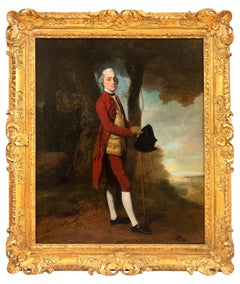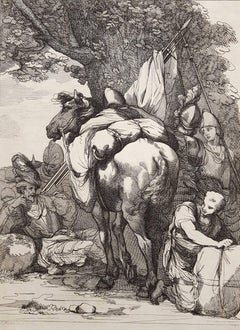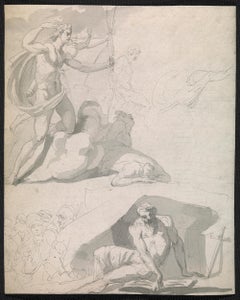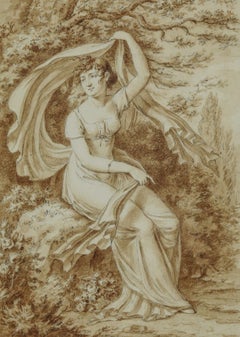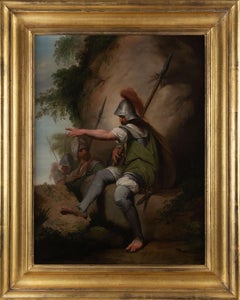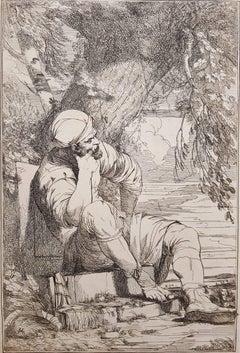John Hamilton Mortimer Art
English, 1740-1779
John Hamilton Mortimer was a British figure and landscape painter and printmaker, known for romantic paintings set in Italy, works depicting conversations and works drawn in the 1770s portraying war scenes, similar to those of Salvator Rosa. Mortimer became President of the Society of Artists in 1774, five years before his death, at age 39.
to
2
3
1
Overall Width
to
Overall Height
to
4
4
2
3
1
4
3
2
2
2
1
1
1
2
2
1
1
1
4
8,816
2,808
1,655
1,313
3
3
1
Artist: John Hamilton Mortimer
An English 18th century portrait of James Stanley, standing in a landscape
By John Hamilton Mortimer
Located in Bath, Somerset
Portrait of James Stanley (1750 - 1810), circa 1775-1778, full-length, wearing a red coat and breeches and a gold embroidered waistcoat, hold...
Category
1770s English School John Hamilton Mortimer Art
Materials
Canvas, Oil, ABS
Packhorse and Soldiers /// Antique British Victorian Etching Figurative Animal
By John Hamilton Mortimer
Located in Saint Augustine, FL
Artist: (after) John Hamilton Mortimer (English, 1740-1779)
Title: "Packhorse and Soldier"
Year: 1783
Medium: Original Etching on watermarked laid paper
Limited edition: Unknown
Prin...
Category
1780s Pre-Raphaelite John Hamilton Mortimer Art
Materials
Etching, Laid Paper, Intaglio
Eighteenth century Old Master drawing - St Jerome
By John Hamilton Mortimer
Located in London, GB
Pen, ink and wash
Framed dimensions: 9 ½ x 11 ¼ inches
Drawn c. 1763
This small, powerful study shows St Jerome contemplating the bible with a cross and sk...
Category
18th Century Old Masters John Hamilton Mortimer Art
Materials
Ink, Pen
Eighteenth century Old Master drawing - Apollo destroying Niobe's children
By John Hamilton Mortimer
Located in London, GB
Pen, ink and wash
Framed dimensions: 13 x 11 ¼ inches
Drawn c.1765
Verso: a study of a hanged man
Mortimer has filled this small sheet with action, depicting in the top right, Apollo and Artemis...
Category
18th Century Old Masters John Hamilton Mortimer Art
Materials
Ink, Pen
Related Items
Jean-Henri Cless (1774-1812) Portrait of a young woman, signed drawing
Located in Paris, FR
Jean-Henri Cless (1774-1812)
Portrait of a young woman in a landscape
signed "Cless fec" for fecit on the lower left
Brown ink and brown ink wash on paper
Size of the sheet : 31.5 x 22 cm
Size of the motive : 24.5 x 17 cm
very simply framed under glass without actual frame 32 x 22.5 cm
This pre...
Category
Early 1800s Old Masters John Hamilton Mortimer Art
Materials
Ink, Pencil
Hand-Colored Penguin Engraving
By George Edwards
Located in New York, NY
Original engraving, hand-colored at the time of publication, after the work of George Edwards from "Sammlung verschneider auslandischer und seltener Vogel" by Johann Michael Seligma...
Category
Mid-18th Century John Hamilton Mortimer Art
Materials
Laid Paper
Mickalene Thomas, Portrait de Priscilla Le Petit Chien official COA S/N, Framed
By Mickalene Thomas
Located in New York, NY
Mickalene Thomas
Portrait de Priscilla Le Petit Chien, 2012
Pigment print on 100% cotton rag paper
Edition 141/150
Frame included with official COA affixed to the back
Hand numbered ...
Category
2010s Realist John Hamilton Mortimer Art
Materials
Laid Paper, Permanent Marker, Digital Pigment
$4,500
H 16 in W 19 in D 1 in
Antique French Impressionist Young Woman Portrait Landscape Framed Oil Painting
By Leon Richet
Located in Buffalo, NY
Antique French impressionist landscape oil painting by Leon Richet (1847 - 1907). Oil on canvas. Signed. Framed. Measuring 22 by 29 inches overall and 15 by 20 painting alone.
Category
1880s Impressionist John Hamilton Mortimer Art
Materials
Canvas, Oil
$1,980 Sale Price
20% Off
H 29 in W 22 in D 2 in
Detailed Contemporary Impressionist Train Station Signed and Framed Oil Painting
Located in Buffalo, NY
Super detailed French impressionist train depot painting. Oil on board. Signed. Framed. Image size, 16"H x 20"L.
Category
1990s Impressionist John Hamilton Mortimer Art
Materials
Canvas, Oil
$780 Sale Price
20% Off
H 20 in W 24 in D 2 in
Mid 17th Century British Old Master Oil Painting Portrait of Man in Flemish City
Located in Cirencester, Gloucestershire
Portrait of Thomas Collard (rector of Withycombe, Somerset 1670-1691)
the city depicted in the distance is thought to be Antwerp.
the portrait historically has been thought to be fr...
Category
Mid-17th Century Old Masters John Hamilton Mortimer Art
Materials
Oil, Canvas
Antique English Elegant Moonlit Young Woman Portrait Framed 19th C Rare Painting
Located in Buffalo, NY
Antique English portrait painting. Watercolor and gouache on paper. Framed. Measuring 17 by 23 inches overall and 10 by 15 painting alone.
Category
1890s Impressionist John Hamilton Mortimer Art
Materials
Canvas, Oil
$780 Sale Price
20% Off
H 23 in W 17 in D 2 in
Fine 1700's Italian Old Master Ink & Wash Drawing Roman Allegorical Africa
Located in Cirencester, Gloucestershire
'Africa'
Italian School, 18th century
ink and wash drawing on paper, framed within a light oak wood frame (behind glass)
image size: 10.5 x 7 inches
overall framed: 17 x 13 inches
co...
Category
18th Century Old Masters John Hamilton Mortimer Art
Materials
Ink, Watercolor, Archival Paper
Fine 1700's Italian Old Master Ink & Wash Drawing Roman Allegorical India
Located in Cirencester, Gloucestershire
'India'
Italian School, 18th century
ink and wash drawing on paper, framed within a light oak wood frame (behind glass)
image size: 10.5 x 7 inches
overall framed: 17 x 13 inches
con...
Category
18th Century Old Masters John Hamilton Mortimer Art
Materials
Ink, Watercolor, Archival Paper
Fine 1700's Italian Old Master Ink & Wash Drawing Roman Allegorical Magnaminita
Located in Cirencester, Gloucestershire
'Mgnaminia'
Italian School, 18th century
ink and wash drawing on paper, framed within a light oak wood frame (behind glass)
image size: 10.5 x 7 inches
overall framed: 17 x 13 inches...
Category
18th Century Old Masters John Hamilton Mortimer Art
Materials
Ink, Watercolor, Archival Paper
French Neo classical school, Allegory of Time, original drawing
Located in Paris, FR
Neo classical school, France, end of the 18th Century
Allegory of Time,
Pen and black ink on paper, gray ink wash
30.5 x 19 cm
irregularly shaped
In g...
Category
1790s Old Masters John Hamilton Mortimer Art
Materials
India Ink
$568 Sale Price
30% Off
H 12.01 in W 7.49 in
Fine 1700's Italian Old Master Ink & Wash Drawing Roman Allegorical Napoli
Located in Cirencester, Gloucestershire
'Napoli'
Italian School, 18th century
ink and wash drawing on paper, framed within a light oak wood frame (behind glass)
image size: 10.5 x 7 inches
overall framed: 17 x 13 inches
co...
Category
18th Century Old Masters John Hamilton Mortimer Art
Materials
Ink, Watercolor, Archival Paper
Previously Available Items
18th century painting of a bandit taking up his post
By John Hamilton Mortimer
Located in London, GB
Collections:
Pulteney Hotel, Bath;
Private collection, Denmark;
Christian B. Peper, acquired in 1985, to 2012.
Literature:
G. Benthall, John Hamilton Mortimer ARA: Drawing and Eng...
Category
18th Century Old Masters John Hamilton Mortimer Art
Materials
Canvas, Oil
Reposo
By John Hamilton Mortimer
Located in Saint Augustine, FL
An original etching on heavy wove paper by English artist John Hamilton Mortimer (1740-1779) titled "Reposo", 1778. Monogram signed in the plate (printed signature) by Mortimer lower...
Category
1770s Pre-Raphaelite John Hamilton Mortimer Art
Materials
Etching
Miller of Trompington and Two Scholars
By John Hamilton Mortimer
Located in Saint Augustine, FL
An original engraving on wove paper after English artist John Hamilton Mortimer (1740-1779) titled "Miller of Trompington and Two Scholars", 1787. Engraved by English artist William ...
Category
1780s Victorian John Hamilton Mortimer Art
Materials
Engraving
John Hamilton Mortimer art for sale on 1stDibs.
Find a wide variety of authentic John Hamilton Mortimer art available for sale on 1stDibs. You can also browse by medium to find art by John Hamilton Mortimer in ink, pen, abs and more. Much of the original work by this artist or collective was created during the 18th century and is mostly associated with the Old Masters style. Not every interior allows for large John Hamilton Mortimer art, so small editions measuring 7 inches across are available. Customers who are interested in this artist might also find the work of George Romney, Jan Pieter Verdussen, and Émile Jean-Horace Vernet . John Hamilton Mortimer art prices can differ depending upon medium, time period and other attributes. On 1stDibs, the price for these items starts at $450 and tops out at $21,660, while the average work can sell for $8,052.
